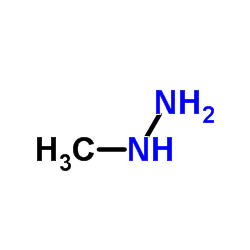monomethylhydrazine

monomethylhydrazine structure
|
Common Name | monomethylhydrazine | ||
|---|---|---|---|---|
| CAS Number | 60-34-4 | Molecular Weight | 46.072 | |
| Density | 0.8±0.1 g/cm3 | Boiling Point | 87.5±9.0 °C at 760 mmHg | |
| Molecular Formula | CH6N2 | Melting Point | -21 °C | |
| MSDS | Chinese USA | Flash Point | 21.1±0.0 °C | |
| Symbol |





GHS02, GHS05, GHS06, GHS08, GHS09 |
Signal Word | Danger | |
|
Francisella tularensis LVS surface and membrane proteins as targets of effective post-exposure immunization for tularemia.
J. Proteome Res. 14(2) , 664-75, (2015) Francisella tularensis causes disease (tularemia) in a large number of mammals, including man. We previously demonstrated enhanced efficacy of conventional antibiotic therapy for tularemia by postexposure passive transfer of immune sera developed against a F.... |
|
|
Enantioselective synthesis of epoxides having a tetrasubstituted trifluoromethylated carbon center: methylhydrazine-induced aerobic epoxidation of β,β-disubstituted enones.
Angew. Chem. Int. Ed. Engl. 52(8) , 2221-5, (2013)
|
|
|
Determination of hydrazine, monomethylhydrazine, 1,1-dimethylhydrazine, and 1,2-dimethylhydrazine by nonaqueous capillary electrophoresis with amperometric detection.
Electrophoresis 26(17) , 3341-8, (2005) The present study is concerned with the application of nonaqueous capillary electrophoresis (NACE) with electrochemical detection (ED) to the separation and quantitative determination of hydrazine (Hy) and its methyl derivatives. The best performance of NACE-... |
|
|
Ion mobility spectrometry of hydrazine, monomethylhydrazine, and ammonia in air with 5-nonanone reagent gas.
Anal. Chem. 65 , 1696-702, (1993) Hydrazine (HZ) and monomethylhydrazine (MMH) in air were monitored continuously using a hand-held ion mobility spectrometer equipped with membrane inlet, 63Ni ion source, acetone reagent gas, and ambient temperature drift tube. Response characteristics includ... |
|
|
Gas chromatography-mass spectrometry determination of the pentafluorobenzoyl derivative of methylhydrazine in false morel (Gyromitra esculenta) as a monitor for the content of the toxin gyromitrin.
J. Chromatogr. A. 1125(2) , 229-33, (2006) The main toxic compound found in false morel (Gyromitra esculenta) is acetaldehyde-N-methyl-N-formylhydrazone (gyromitrin). This paper describes a method of determining the total hydrazones content based on acid hydrolysis of gyromitrin and other related hydr... |
|
|
The effect of dietary selenium deficiency on acute colorectal mucosal nucleotoxicity induced by several carcinogens in the rodent.
Am. J. Surg. 172(1) , 85-8, (1996) Selenium (SE) has been inversely associated with colon cancer risk. Two potential mechanisms of this effect were examined in a rodent short-term carcinogenesis assay: whether dietary SE deficiency altered the initiation aspect of carcinogenesis in the colon, ... |
|
|
Carbon-centered free radical formation during the metabolism of hydrazine derivatives by neutrophils.
Biochem. Pharmacol. 45(9) , 1913-9, (1993) The neutrophil-catalyzed metabolism of hydrazine derivatives to carbon-centered radicals was investigated by the spin-trapping technique using alpha-(4-pyridyl-1-oxide)-N-tert-butylnitrone (POBN). Oxidation of methylhydrazine (MeH), dimethylhydrazine (DMH), p... |
|
|
Suicide inactivation of hydroxylamine oxidoreductase of Nitrosomonas europaea by organohydrazines.
Biochemistry 34(28) , 9257-64, (1995) In the presence of a suitable electron acceptor such as mammalian cytochrome c, hydroxylamine oxidoreductase (HAO) from the chemolithotrophic bacterium Nitrosomonas europaea catalyzes the oxidation of hydroxylamine or hydrazine to nitrite or dinitrogen, respe... |
|
|
Formation and decay of tetrazane derivatives--a Car-Parrinello molecular dynamics study.
Phys. Chem. Chem. Phys. 10(30) , 4383-92, (2008) The complications during flight 510 of the Ariane Project were ascribed to problems in the upper stage engine that employs the bipropellant monomethylhydrazine (MMH) and nitrogen tetroxide (NTO). This has led to the question what conditions or reactions possi... |
|
|
Toxicological studies of the false morel (Gyromitra esculenta): embryotoxicity of monomethylhydrazine in the rat.
Food Addit. Contam. 10(4) , 391-8, (1993) The embryotoxic and teratogenic potential of monomethylhydrazine (MMH), a toxic component of the widely consumed false morel (Gyromitra esculenta), was studied in rat. Groups of pregnant Sprague-Dawley rats received MMH as a constant i.v. infusion via implant... |